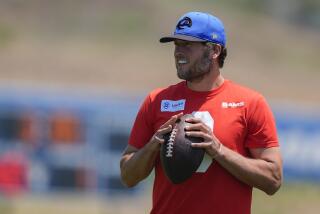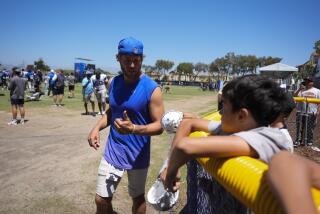With all the great passing, NFL remains a rushing league
The NFL is a passing league. That’s more evident than ever this season with all sorts of yardage records being set each week.
But the NFL is also a rushing league. If a player is injured — particularly a quarterback — he’s routinely rushed back into action.
Among the recent examples:
•A flak-jacketed Tony Romo played Monday for the Dallas Cowboys despite suffering cracked ribs and a punctured lung the week before.
• Philadelphia’s Michael Vick was back in action a week after suffering a concussion. Since the league put in new standards regarding concussions, Vick reportedly is only the second player to be diagnosed with a concussion who was cleared to play the following week.
• Before Peyton Manning underwent his most recent neck surgery, Indianapolis reportedly flirted with the idea of using him only in red-zone situations. Now, the Colts are dealing with a concussed Kerry Collins.
“There’s a mentality that permeates from the owners to the general managers to the coaches that this is a man’s league,” former NFL quarterback Boomer Esiason said. “Men are going to be men, and men are going to do things that only men would do. It’s a Marine way of thinking. I don’t think that coincides with the lip service that we’ve been hearing.”
Most of the pressure, Esiason said, comes from the players themselves. They don’t want to miss time, especially if they’re coming off the type of game Romo had in the opener when the Cowboys folded down the stretch against the New York Jets.
“So all week long he’s hearing how he’s a choker, how he made the mistake, and questions about how the Cowboys are ever going to get to the Super Bowl because he’s no Roger Staubach or Troy Aikman,” said Esiason, a CBS analyst.
“It’s so high profile because it’s the Cowboys, it’s the starting quarterback, and because he had such a fantastic finish [against San Francisco the following week]. You kind of juxtapose that to where he was the week before, and now all of a sudden he’s got people off his back.”
In the case of Vick, he missed the end of the Atlanta game in Week 2 after suffering the concussion. Over the next few days, he was tested and cleared to return, practicing Thursday and Friday. He started Sunday against the New York Giants, and the Eagles backs ran more than usual.
In the third quarter, Vick suffered what was initially diagnosed as a broken right hand — an injury that occurred on the same play when he absorbed a helmet hit in his facemask. He was taken to the locker room, quickly X-rayed, and returned before missing a play. When a second set of X-rays was analyzed, and the Eagles feared a fracture, Vick was removed from the game.
On Monday, the diagnosis was downgraded to a contusion, leaving open the possibility Vick could return for next Sunday’s game against San Francisco.
Collins, Manning’s replacement in Indianapolis, sustained a concussion against Pittsburgh on Sunday night and was replaced by Curtis Painter. The Colts are continuing to evaluate Collins and have not said whether he will start Monday at Tampa Bay, or whether Painter will make his first career start. It’s probable that the team will take its time announcing that decision, if only for a strategic edge.
“We always talk about your greatest ability is your availability,” said former NFL quarterback Rich Gannon, also a CBS analyst. “These guys play hurt every week. You’ve got to look at the alternative. The guy behind you for the most part is not the same player, not the same experience, hasn’t had the same work in practice. The great example of that is Manning to Painter.”
Esiason played 14 seasons, made four Pro Bowls, was the league’s most valuable player in 1988 and took the Cincinnati Bengals to the Super Bowl. Although he had his share of bad sprains, he never had a broken bone and never took a painkiller shot to play.
Gannon played 17 seasons, made four Pro Bowls, was the NFL’s MVP in 2002, and took the Oakland Raiders to the Super Bowl. However, he took painkiller shots when necessary. One of those instances was the AFC championship game against Baltimore in early 2001, when Gannon was flattened by defensive tackle Tony Siragusa in the second quarter and suffered a third-degree shoulder separation.
“I got two or three injections in the shoulder and tried to go back out and play,” Gannon said. “I couldn’t even lift my arm. The doctor who put the injections in had to lift my arm.
“My gosh, you’re pale white and light-headed. You see the needle and they’re sticking it right in the joint. They leave it in there and they’re moving it around. It’s a bad deal.”
Gannon said there was no hesitation to try to return at the time. The second guessing comes later.
“You look back on some of the things that you did and go, ‘Maybe that wasn’t such a good idea,’” he said. “But those are decisions that each individual has to make. Some guys quite frankly don’t have the pain threshold. Some guys don’t have the ability to do it.
“Those are the guys that usually don’t last long in this business.”
More to Read
Go beyond the scoreboard
Get the latest on L.A.'s teams in the daily Sports Report newsletter.
You may occasionally receive promotional content from the Los Angeles Times.











